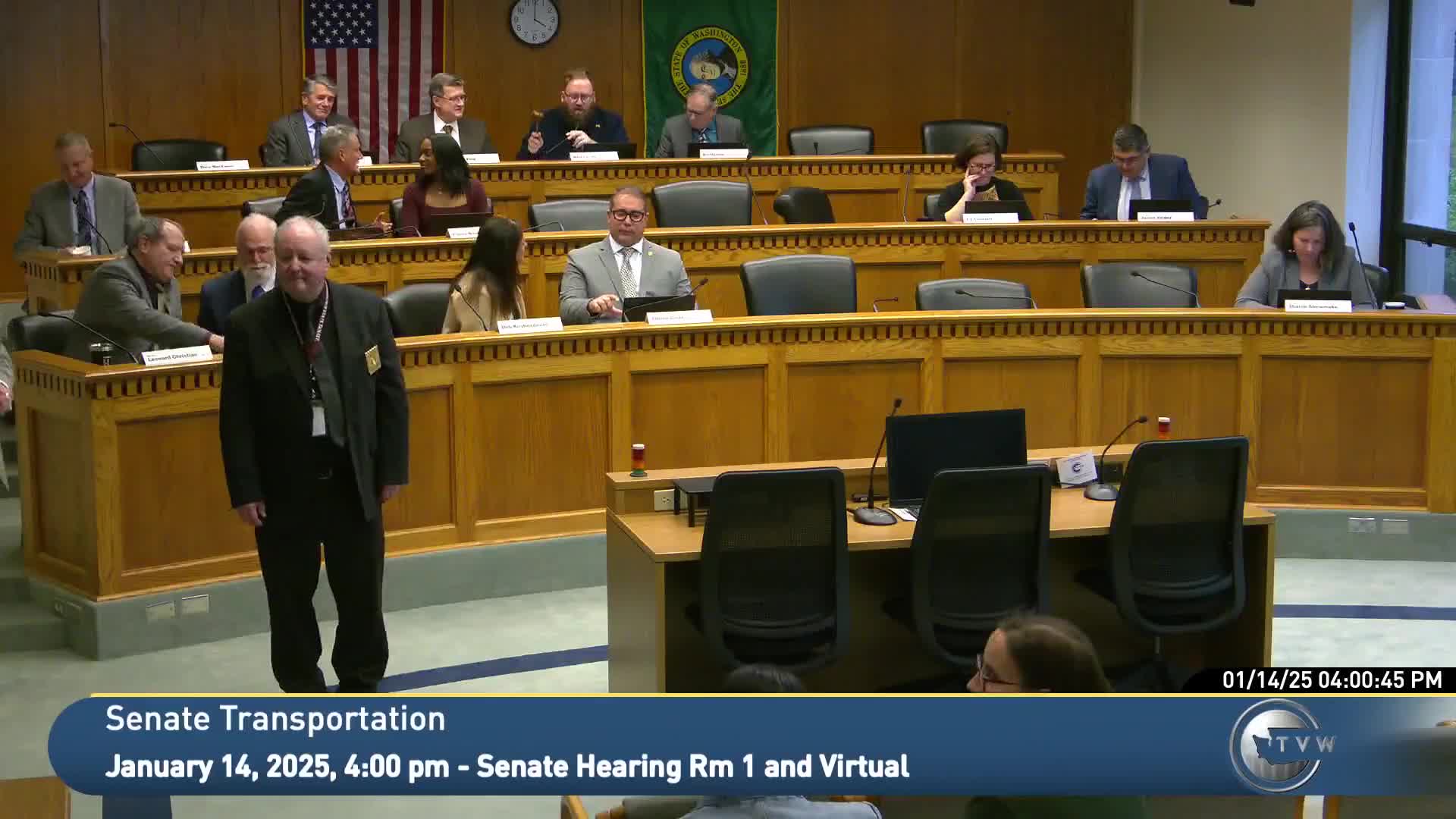Senate hears overview of Gov. Inslee transportation budget; panel flags $1 billion capital shortfall
January 14, 2025 | Transportation, Senate, Legislative Sessions, Washington
This article was created by AI summarizing key points discussed. AI makes mistakes, so for full details and context, please refer to the video of the full meeting. Please report any errors so we can fix them. Report an error »

Chair Lias convened a work session and public hearing of the Washington State Senate Transportation Committee on Jan. 14, 2025, to review Governor Jay Inslee's proposed transportation budget and receive public testimony on Senate Bill 5161, the 2025–27 transportation appropriations bill.
Office of Financial Management senior policy advisor Megan Cotton and senior budget advisor Eric Hansen presented the budget overview, telling senators that the governor built a current-law budget that assumes no new transportation revenue and identifies a roughly $1,000,000,000 shortfall in the capital improvement program for the next biennium. Hansen said revenue forecasts used to build the budget show a decline of more than $500,000,000 between February and November 2024 and estimated a 10‑year revenue drop of about $2.2 billion. He also cited roughly $1.3 billion in project cost increases, producing the current-biennium gap.
The presentation said the governor’s proposed transportation budget totals about $14.7 billion across agencies, including roughly $1.8 billion in debt-service payments and about $12.8 billion in agency spending. The budget continues existing programs without adding new statewide revenue; it also relies on Climate Commitment Act auction revenue, which the presentation noted will provide the first tranche of CCA funding directed to transportation—about $718 million in the first biennium. Hansen and Cotton highlighted targeted investments in fish-passage design funding, tolling implementation work, ferry operations and safety, and continuation of a work-zone speed camera program that had been funded one-time in the current biennium.
Megan Cotton said the governor chose to identify challenges rather than prescribe solutions, leaving choices about closing the capital shortfall to the incoming administration and the legislature. Committee members asked about bonding against toll revenue; OFM staff answered that toll-backed bond sales rely on a sequence of analyses culminating in an investment-grade toll-and-revenue study for investors, but warned that unforeseen events such as the COVID-19 pandemic can alter revenue outcomes.
The committee then moved to a public hearing on SB 5161. Dozens of witnesses testified on specific projects, local priorities and programmatic funding, including requests for additional construction funds, planning dollars for the SR 167 implementation plan, safety improvements on Highway 18 and Highway 101, ferry capacity and shipyard investment, transit and rail capital needs, and continued use of CCA funds for transit, zero-emission vehicle programs and active-transportation projects.
No votes were taken during the hearing; OFM staff and the governor’s policy advisors offered to return for follow-up questions.
Office of Financial Management senior policy advisor Megan Cotton and senior budget advisor Eric Hansen presented the budget overview, telling senators that the governor built a current-law budget that assumes no new transportation revenue and identifies a roughly $1,000,000,000 shortfall in the capital improvement program for the next biennium. Hansen said revenue forecasts used to build the budget show a decline of more than $500,000,000 between February and November 2024 and estimated a 10‑year revenue drop of about $2.2 billion. He also cited roughly $1.3 billion in project cost increases, producing the current-biennium gap.
The presentation said the governor’s proposed transportation budget totals about $14.7 billion across agencies, including roughly $1.8 billion in debt-service payments and about $12.8 billion in agency spending. The budget continues existing programs without adding new statewide revenue; it also relies on Climate Commitment Act auction revenue, which the presentation noted will provide the first tranche of CCA funding directed to transportation—about $718 million in the first biennium. Hansen and Cotton highlighted targeted investments in fish-passage design funding, tolling implementation work, ferry operations and safety, and continuation of a work-zone speed camera program that had been funded one-time in the current biennium.
Megan Cotton said the governor chose to identify challenges rather than prescribe solutions, leaving choices about closing the capital shortfall to the incoming administration and the legislature. Committee members asked about bonding against toll revenue; OFM staff answered that toll-backed bond sales rely on a sequence of analyses culminating in an investment-grade toll-and-revenue study for investors, but warned that unforeseen events such as the COVID-19 pandemic can alter revenue outcomes.
The committee then moved to a public hearing on SB 5161. Dozens of witnesses testified on specific projects, local priorities and programmatic funding, including requests for additional construction funds, planning dollars for the SR 167 implementation plan, safety improvements on Highway 18 and Highway 101, ferry capacity and shipyard investment, transit and rail capital needs, and continued use of CCA funds for transit, zero-emission vehicle programs and active-transportation projects.
No votes were taken during the hearing; OFM staff and the governor’s policy advisors offered to return for follow-up questions.
View full meeting
This article is based on a recent meeting—watch the full video and explore the complete transcript for deeper insights into the discussion.
View full meeting
